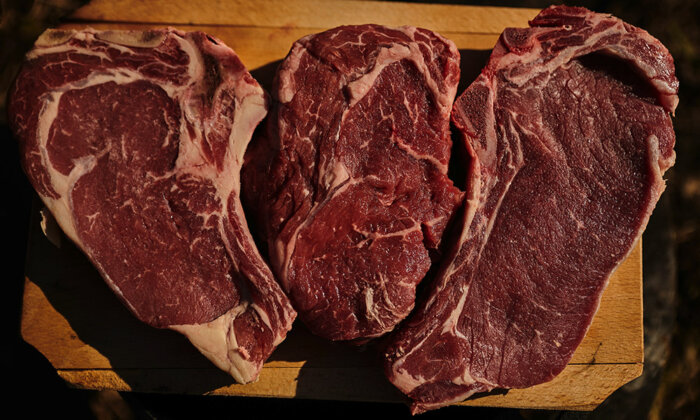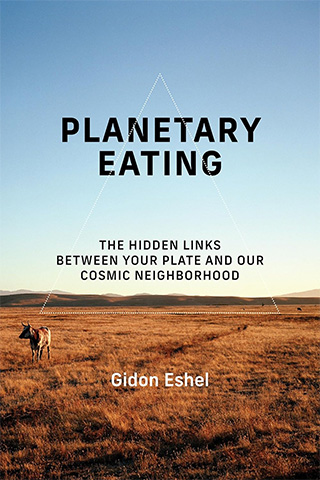The “We Evolved to Eat Meat” Argument Doesn’t Hold Up

One of the most enduring defenses of meat-eating is that we evolved to do it, and therefore must continue to do so. The claim goes that our ape and hominin ancestors were frequent, even obligatory meat eaters, and that we thus remain obligatory meat eaters. Most recently, this idea was invoked to promote yet another magical diet that would reverse weight gain and keep degenerative diseases at bay, the so-called “paleo” diet.
The argument primarily focuses on a period in our evolutionary history during which our brain expanded rapidly while our digestive system shrank, which is taken to reflect a dietary transition from plants to meat. From this, proponents suggest a causal link in which meat was the indispensable fuel that propelled the development of bigger brains during our evolutionary transition from apes to abstract analysts. The argument may be true, but if the composition of current or prehistoric diets is not particularly well known, certainly not in geographical details, how well can we expect to know diets two million years ago? Moreover, while eating meat in general requires smaller digestive tracts, the validity of this association is limited. At roughly 400 to 600 calories and 10 to 20 grams of protein per 100 grams, nuts and seeds are low-volume, high-nutritional-density foods for which small stomachs suffice. Top them off with peanuts and some honey, and you can do well as a plump, small-stomach, obligatory plant-eater.

Want more numerical specificity? Suppose we explore replacing modern beef with various plant-based alternatives, and calculate how much of each plant food we’d need to fully match the calories and protein in the beef. For each plant, we get two answers — one for replacing all the energy, and another for all the protein. From these two answers, we use the more exacting one, the one that requires more mass.
To test whether plants can match the nutritional value of meat, I compared 59 plant foods to beef. Of those, seven — almonds, kidney beans, peanuts, pistachios, chickpeas, lentils, and soy — require replacement masses that are in fact smaller than that of the beef they replace, on average requiring 800 grams to replace a kilogram of beef. Six more — barley, hazelnuts, oats, walnuts, buckwheat, and spelt — require only slightly higher masses (20 percent higher on average) than the beef mass they replace for the exact full energy–protein replacement.
The notion that our diet requires meat thus confronts roaring headwinds. While Pleistocene forebears of these nuts and legumes differed markedly from their modern counterparts, the message is clear: If more than 2 in 10 plant items are just as energy- and protein-dense as game meat, early plant-eating hominins could have invested relatively modest efforts in gathering plant-based diets with no less protein and energy, and no more bulk than large game eating would have provided, with none of the serious risks inherent in big-game hunting. This is why I find this argument unpersuasive.
Even if our exceptional analytical skills did require meat to fuel this evolutionary upgrade, given how vastly biologically, socially, environmentally, physiologically, and nutritionally different our lives are from those of our early evolutionary forebearers, how useful is this association to guide dietary choices today?
Health records of 4.5 million patients show that modern consumers face health risks, not benefits, when they choose to eat meat.
In fact, health records of 4.5 million patients show that modern consumers face health risks, not benefits, when they choose to eat meat: Increasing your unprocessed red meat consumption by 100 grams per day raises your cardiovascular risk by 5 to 16 percent, and doubling red meat intake roughly doubles the odds of death. Even if meat played a role in our evolution, therefore, its modern pervasive overconsumption comes with significant health costs.
The physiological challenges modern diets must address and biochemically protect us from — long lives with virtually no existentially required activity and unlimited food supplies — clearly have little overlap with the challenges our ancestors faced: predation by larger predators, unpredictable food supply, and brief, violent lives.
With that, let’s reexamine the “paleo” diet. Suppose, despite these game-changing differences, that a “paleo” diet is nutritionally wise for modern humans; is it deployable? I’d say not even minimally, because it is practically impossible to ever find meat, cereals, or greens that even vaguely resemble their paleolithic predecessors. For example, even lean grass-fed beef or bison, the nearest crude modern analog to hunted Pleistocene fauna, are still 2 to 3 times fattier than wild meat and surely even more distinct in micronutrients. Likewise, how similar to their naturally occurring counterparts are, for example, manicured arugula or hyper-bred strawberries?
Likely not particularly. In my decidedly unmanicured yard, the wild strawberries are as distinct in shape, size, taste, and abundance from their grotesquely enormous modern counterparts as a modern confined dairy cow is from her Holocene aurochs progenitors. One proxy for this comparison is the difference between organic produce and conventional counterparts, where large micronutrient differences are observed, yet likely understate the differences we are after, because modern organic produce is anything but wild. While further research is needed, the case for a “paleo” diet that can be reasonably characterized as promoting health in the 21st century is yet to be made. A recent effort to evaluate the paleo diet concluded that the current evidence is insufficient to recommend it even for the clinical objective the diet is most likely to achieve: diabetes management.
An earlier one described the paleo diet as “an expensive and not nutritionally adequate diet with a high carbon footprint.” As to the odds of success for future efforts to corroborate the purported benefits of the paleo diet, I find it interesting that one effort to examine this topic was published in the journal Utopian Studies…
Yet the desire to defend meat often bypasses such limitations entirely. Consider one widely circulated 2019 article (“Controversial Studies Say It’s OK to Eat Red Meat”) that downplayed the risks of red meat consumption. Since its publication, the methodologies and ethics of these papers have been questioned (the group, it was later learned, had ties to a program partly backed by the beef industry). Perhaps most peculiar is their “preferred diet,” derived from votes by a 14-member panel, of which three were not scientists but “community members” who reviewed people’s “values and preferences regarding meat consumption.” That is, the “preferred diet” is based on the subjective personal preferences of lay persons. Rather than answering “Is eating beef healthy?” the authors instead answered “Do people like beef?” which is both obvious (they do, or else the beef market would have collapsed) and irrelevant (the issue is health, not popularity). Given these failings, the only lessons these papers teach us are not about diet but about the perils of research that is not meant to reduce our epidemiological ignorance but to collect social media likes by “proving” a predetermined point.
While the nutritional case for a “paleo” diet is being litigated in the scientific literature, the environmental case against “paleo” diets is strong.
While the nutritional case for a “paleo” diet is being litigated in the scientific literature, the environmental case against “paleo” diets is strong, mostly because of its strong emphasis on meat, especially beef, and other animal products.
The above discussion of “paleo” diets is related to but logically distinct from the promotion of wild animal consumption by some in the “meat is essential” camp, most compellingly and eloquently relayed by Steve Rinella. While interesting, this thinking is irrelevant to the question at hand, because we are interested in population statistics, not one outdoorsman’s awesome skills (which are very dear to my heart, and which Rinella beautifully and convincingly showcases). If you are unsure what distinction I am drawing here or why it matters, try recalling the last time you killed your meat, field-butchered it, carried it on your back for many miles, and cooked it over an open fire, as Rinella describes. However endearing and compelling these exploits are, they are no more relevant to population-level modern diets than Robin Hood is to modern fiscal policies.
Emotionally, this is similar to our relationships with multifaceted protagonists. Beautifully capturing this is Jim Brewton, a focal protagonist in Conrad Richter’s “Sea of Grass.” A retired colonel turned rancher, Brewton is rich, entitled, imperious, often insufferably overbearing, and at times violent. His worst vitriol is reserved for “nesters,” homesteaders who favor plowing the native prairie for corn or wheat instead of running cattle on it, which in Brewton’s eyes is the only conceivable use for that vast arid expanse. It is so tempting to write Brewton off as the detestable epitome of all that was wrong with Westward Expansion. And yet, for students of history, Brewton’s contemptuous rejection of “nesting” is prophetic, portraying succinctly a deep understanding of the workings of montane semiarid steppes, and the limits on their use. Recklessly ignoring this knowledge between the 1880s and 1929 is precisely what ushered in the worst environmental catastrophe in U.S. history, the Dust Bowl.
At heart, “Sea of Grass” delivers a most environmentally enlightened and informed message, but it does so using a most improbable, ill-fitting messenger, as elegant a demonstration of the many gray shades of environmental thinking as I have come across. If we are perfectly comfortable with such ambiguity in novels and films, why should we have any difficulty living with similar indeterminacy in environmental and nutritional realms?
Gidon Eshel is Research Professor at Bard. He completed a postdoc at the Harvard Center for Planetary Physics, where he was a NOAA Global and Climate Change Fellow, and received a Radcliffe Fellowship in 2016. He is the author of “Planetary Eating,” from which this article is adapted.



